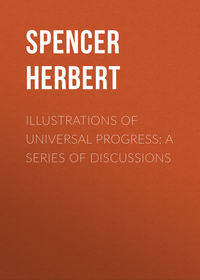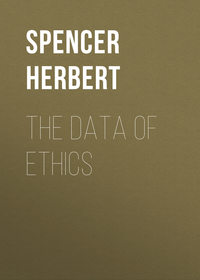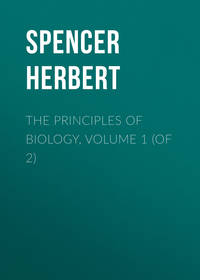 полная версия
полная версияEssays: Scientific, Political, and Speculative, Volume II
It is not surprising that, starting from such premises, and reasoning after this fashion, Hegel finds his way to strange conclusions. Out of space and time he proceeds to build up motion , matter , repulsion , attraction , weight , and inertia. He then goes on to logically evolve the solar system. In doing this he widely diverges from the Newtonian theory; reaches by syllogism the conviction that the planets are the most perfect celestial bodies; and, not being able to bring the stars within his theory, says that they are mere formal existences and not living matter, and that as compared with the solar system they are as little admirable as a cutaneous eruption or a swarm of flies. 1 Results so absurd might be left as self-disproved, were it not that speculators of this class are not alarmed by any amount of incongruity with established beliefs. The only efficient mode of treating systems like this of Hegel, is to show that they are self-destructive – that by their first steps they ignore that authority on which all their subsequent steps depend. If Hegel professes, as he manifestly does, to develop his scheme by reasoning – if he presents successive inferences as necessarily following from certain premises; he implies the postulate that a belief which necessarily follows after certain antecedents is a true belief; and did an opponent reply to one of his inferences that, though it was impossible to think the opposite, yet the opposite was true, he would consider the reply irrational. The procedure, however, which he would thus condemn as destructive of all thinking whatever, is just the procedure exhibited in the enunciation of his own first principles. Mankind find themselves unable to conceive that there can be thought without things thought of. Hegel, however, asserts that there can be thought without things thought of. That ultimate test of a true proposition – the inability of the human mind to conceive the negation of it – which in all the successive steps of his arguments he considers valid, he considers invalid where it suits his convenience to do so; and yet at the same time denies the right of an opponent to follow his example. If it is competent for him to posit dogmas which are the direct negations of what human consciousness recognizes; then is it also competent for his antagonists to stop him at any moment by saying, that though the particular inference he is drawing seems to his mind, and to all minds, necessarily to follow from the premises, yet it is not true, but the contrary inference is true. Or, to state the dilemma in another form: – If he sets out with inconceivable propositions, then may he with equal propriety make all his succeeding propositions inconceivable ones – may at every step throughout his reasoning draw the opposite conclusion to that which seems involved.
Hegel’s mode of procedure being thus essentially suicidal, the Hegelian classification which depends upon it, falls to the ground. Let us consider next that of M. Comte.
As all his readers must admit, M. Comte presents us with a scheme of the sciences which, unlike the foregoing ones, demands respectful consideration. Widely as we differ from him, we cheerfully bear witness to the largeness of his views, the clearness of his reasoning, and the value of his speculations as contributing to intellectual progress. Did we believe a serial arrangement of the sciences to be possible, that of M. Comte would certainly be the one we should adopt. His fundamental propositions are thoroughly intelligible; and, if not true, have a great semblance of truth. His successive steps are logically co-ordinated; and he supports his conclusions by a considerable amount of evidence – evidence which, so long as it is not critically examined, or not met by counter evidence, seems to substantiate his positions. But it only needs to assume that antagonistic attitude which ought to be assumed towards new doctrines, in the belief that, if true, they will prosper by conquering objectors – it needs but to test his leading doctrines either by other facts than those he cites, or by his own facts differently applied, to show that they will not stand. We will proceed thus to deal with the general principle on which he bases his hierarchy of the sciences.
In the condensed translation of the Positive Philosophy , by Miss Martineau, M. Comte says: – “Our problem is, then, to find the one rational order, amongst a host of possible systems.”. “This order is determined by the degree of simplicity, or, what comes to the same thing, of generality of their phenomena.” And the arrangement he deduces runs thus: – Mathematics , Astronomy , Physics , Chemistry , Physiology , Social Physics. This he asserts to be “the true filiation of the sciences.” He asserts further, that the principle of progression from a greater to a less degree of generality, “which gives this order to the whole body of science, arranges the parts of each science.” And, finally, he asserts that the gradations thus established à priori among the sciences and the parts of each science, “is in essential conformity with the order which has spontaneously taken place among the branches of natural philosophy;” or, in other words – corresponds with the order of historic development.
Let us compare these assertions with the facts. That there may be perfect fairness, let us make no choice, but take as the field for our comparison, the succeeding section treating of the first science – Mathematics; and let us use none but M. Comte’s own facts, and his own admissions. Confining ourselves to this one science, we are limited to comparisons between its several parts. M. Comte says, that the parts of each science must be arranged in the order of their decreasing generality; and that this order of decreasing generality agrees with the order of historic development. Our inquiry will be, then, whether the history of mathematics confirms this statement.
Carrying out his principle, M. Comte divides Mathematics into “Abstract Mathematics, or the Calculus (taking the word in its most extended sense) and Concrete Mathematics, which is composed of General Geometry and of Rational Mechanics.” The subject-matter of the first of these is number; the subject-matter of the second includes space , time , motion , force. The one possesses the highest possible degree of generality; for all things whatever admit of enumeration. The others are less general; seeing that there are endless phenomena that are not cognizable either by general geometry or rational mechanics. In conformity with the alleged law, therefore, the evolution of the calculus must throughout have preceded the evolution of the concrete sub-sciences. Now somewhat awkwardly for him, the first remark M. Comte makes bearing on this point is, that “from an historical point of view, mathematical analysis appears to have arisen out of the contemplation of geometrical and mechanical facts.” True, he goes on to say that, “it is not the less independent of these sciences logically speaking;” for that “analytical ideas are, above all others, universal, abstract, and simple; and geometrical conceptions are necessarily founded on them.” We will not take advantage of this last passage to charge M. Comte with teaching, after the fashion of Hegel, that there can be thought without things thought of. We are content simply to compare the assertion, that analysis arose out of the contemplation of geometrical and mechanical facts, with the assertion that geometrical conceptions are founded upon analytical ones. Literally interpreted they exactly cancel each other. Interpreted, however, in a liberal sense, they imply, what we believe to be demonstrable, that the two had a simultaneous origin. The passage is either nonsense, or it is an admission that abstract and concrete mathematics are coeval. Thus, at the very first step, the alleged congruity between the order of generality and the order of evolution, does not hold good.
But may it not be that though abstract and concrete mathematics took their rise at the same time, the one afterwards developed more rapidly than the other; and has ever since remained in advance of it? No: and again we call M. Comte himself as witness. Fortunately for his argument he has said nothing respecting the early stages of the concrete and abstract divisions after their divergence from a common root; otherwise the advent of Algebra long after the Greek geometry had reached a high development, would have been an inconvenient fact for him to deal with. But passing over this, and limiting ourselves to his own statements, we find, at the opening of the next chapter, the admission, that “the historical development of the abstract portion of mathematical science has, since the time of Descartes, been for the most part determined by that of the concrete.” Further on we read respecting algebraic functions that “most functions were concrete in their origin – even those which are at present the most purely abstract; and the ancients discovered only through geometrical definitions elementary algebraic properties of functions to which a numerical value was not attached till long afterwards, rendering abstract to us what was concrete to the old geometers.” How do these statements tally with his doctrine? Again, having divided the calculus into algebraic and arithmetical, M. Comte admits, as perforce he must, that the algebraic is more general than the arithmetical; yet he will not say that algebra preceded arithmetic in point of time. And again, having divided the calculus of functions into the calculus of direct functions (common algebra) and the calculus of indirect functions (transcendental analysis), he is obliged to speak of this last as possessing a higher generality than the first; yet it is far more modern. Indeed, by implication, M. Comte himself confesses this incongruity; for he says: – “It might seem that the transcendental analysis ought to be studied before the ordinary, as it provides the equations which the other has to resolve. But though the transcendental is logically independent of the ordinary , it is best to follow the usual method of study, taking the ordinary first.” In all these cases, then, as well as at the close of the section where he predicts that mathematicians will in time “create procedures of a wider generality ,” M. Comte makes admissions that are diametrically opposed to the alleged law.
In the succeeding chapters treating of the concrete department of mathematics, we find similar contradictions. M. Comte himself names the geometry of the ancients special geometry and that of the moderns general geometry. He admits that while “the ancients studied geometry with reference to the bodies under notice, or specially; the moderns study it with reference to the phenomena to be considered, or generally.” He admits that while “the ancients extracted all they could out of one line or surface before passing to another,” “the moderns, since Descartes, employ themselves on questions which relate to any figure whatever.” These facts are the reverse of what, according to his theory, they should be. So, too, in mechanics. Before dividing it into statics and dynamics, M. Comte treats of the three laws of motion , and is obliged to do so; for statics, the more general of the two divisions, though it does not involve motion, is impossible as a science until the laws of motion are ascertained. Yet the laws of motion pertain to dynamics, the more special of the divisions. Further on he points out that after Archimedes, who discovered the law of equilibrium of the lever, statics made no progress until the establishment of dynamics enabled us to seek “the conditions of equilibrium through the laws of the composition of forces.” And he adds – “At this day this is the method universally employed. At the first glance it does not appear the most rational – dynamics being more complicated than statics, and precedence being natural to the simpler. It would, in fact, be more philosophical to refer dynamics to statics, as has since been done.” Sundry discoveries are afterwards detailed, showing how completely the development of statics has been achieved by considering its problems dynamically; and before the close of the section M. Comte remarks that “before hydrostatics could be comprehended under statics, it was necessary that the abstract theory of equilibrium should be made so general as to apply directly to fluids as well as solids. This was accomplished when Lagrange supplied, as the basis of the whole of rational mechanics, the single principle of virtual velocities.” In which statement we have two facts directly at variance with M. Comte’s doctrine; – first, that the simpler science, statics, reached its present development only by the aid of the principle of virtual velocities, which belongs to the more complex science, dynamics; and that this “single principle” underlying all rational mechanics – this most general form which includes alike the relations of statical, hydrostatical, and dynamical forces – was reached so late as the time of Lagrange.
Thus it is not true that the historical succession of the divisions of mathematics has corresponded with the order of decreasing generality. It is not true that abstract mathematics was evolved antecedently to, and independently of, concrete mathematics. It is not true that of the subdivisions of abstract mathematics, the more general came before the more special. And it is not true that concrete mathematics, in either of its two sections, began with the most abstract and advanced to the less abstract truths.
It may be well to mention, parenthetically, that, in defending his alleged law of progression from the general to the special, M. Comte somewhere comments upon the two meanings of the word general , and the resulting liability to confusion. Without now discussing whether the asserted distinction exists in other cases, it is manifest that it does not exist here. In sundry of the instances above quoted, the endeavours made by M. Comte himself to disguise, or to explain away, the precedence of the special over the general, clearly indicate that the generality spoken of is of the kind meant by his formula. And it needs but a brief consideration of the matter to show that, even did he attempt it, he could not distinguish this generality which, as above proved, frequently comes last, from the generality which he says always comes first. For what is the nature of that mental process by which objects, dimensions, weights, times, and the rest, are found capable of having their relations expressed numerically? It is the formation of certain abstract conceptions of unity, duality, and multiplicity, which are applicable to all things alike. It is the invention of general symbols serving to express the numerical relations of entities, whatever be their special characters. And what is the nature of the mental process by which numbers are found capable of having their relations expressed algebraically? It is the same. It is the formation of certain abstract conceptions of numerical functions which are constant whatever be the magnitudes of the numbers. It is the invention of general symbols serving to express the relations between numbers, as numbers express the relations between things. Just as arithmetic deals with the common properties of lines, areas, bulks, forces, periods; so does algebra deal with the common properties of the numbers which arithmetic presents.
Having shown that M. Comte’s alleged law of progression does not hold among the several parts of the same science, let us see how it agrees with the facts when applied to the separate sciences. “Astronomy,” says M. Comte ( Positive Philosophy , Book III.), “was a positive science, in its geometrical aspect, from the earliest days of the school of Alexandria; but Physics, which we are now to consider, had no positive character at all till Galileo made his great discoveries on the fall of heavy bodies.” On this, our comment is simply that it is a misrepresentation based upon an arbitrary misuse of words – a mere verbal artifice. By choosing to exclude from terrestrial physics those laws of magnitude, motion, and position, which he includes in celestial physics, M. Comte makes it appear that the last owes nothing to the first. Not only is this unwarrantable, but it is radically inconsistent with his own scheme of divisions. At the outset he says – and as the point is important we quote from the original – “Pour la physique inorganique nous voyons d’abord, en nous conformant toujours à l’ordre de généralité et de dépendance des phénomènes, qu’elle doit être partagée en deux sections distinctes, suivant qu’elle considère les phénomènes généraux de l’univers, ou, en particulier, ceux que présentent les corps terrestres. D’où la physique céleste, ou l’astronomie, soit géométrique, soit mechanique; et la physique terrestre.” Here then we have inorganic physics clearly divided into celestial physics and terrestrial physics – the phenomena presented by the universe, and the phenomena presented by earthly bodies. If now celestial bodies and terrestrial bodies exhibit sundry leading phenomena in common, as they do, how can the generalization of these common phenomena be considered as pertaining to the one class rather than to the other? If inorganic physics includes geometry (which M. Comte has made it do by comprehending geometrical astronomy in its sub-section, celestial physics); and if its other sub-section, terrestrial physics, treats of things having geometrical properties; how can the laws of geometrical relations be excluded from terrestrial physics? Clearly if celestial physics includes the geometry of objects in the heavens, terrestrial physics includes the geometry of objects on the earth. And if terrestrial physics includes terrestrial geometry, while celestial physics includes celestial geometry, then the geometrical part of terrestrial physics precedes the geometrical part of celestial physics; seeing that geometry gained its first ideas from surrounding objects. Until men had learnt geometrical relations from bodies on the earth, it was impossible for them to understand the geometrical relations of bodies in the heavens. So, too, with celestial mechanics, which had terrestrial mechanics for its parent. The very conception of force , which underlies the whole of mechanical astronomy, is borrowed from our earthly experiences; and the leading laws of mechanical action as exhibited in scales, levers, projectiles, &c., had to be ascertained before the dynamics of the Solar System could be entered upon. What were the laws made use of by Newton in working out his grand discovery? The law of falling bodies disclosed by Galileo; that of the composition of forces also disclosed by Galileo; and that of centrifugal force found out by Huyghens – all of them generalizations of terrestrial physics. Yet, with facts like these before him, M. Comte places astronomy before physics in order of evolution! He does not compare the geometrical parts of the two together, and the mechanical parts of the two together; for this would by no means suit his hypothesis. But he compares the geometrical part of the one with the mechanical part of the other, and so gives a semblance of truth to his position. He is led away by a verbal illusion. Had he confined his attention to the things and disregarded the words, he would have seen that before mankind scientifically co-ordinated any one class of phenomena displayed in the heavens, they had previously co-ordinated a parallel class of phenomena displayed on the surface of the earth.
Were it needful we could fill a score pages with the incongruities of M. Comte’s scheme. But the foregoing samples will suffice. So far is his law of evolution of the sciences from being tenable, that, by following his example, and arbitrarily ignoring one class of facts, it would be possible to present, with great plausibility, just the opposite generalization to that which he enunciates. While he asserts that the rational order of the sciences, like the order of their historic development, “is determined by the degree of simplicity, or, what comes to the same thing, of generality of their phenomena;” it might contrariwise be asserted that, commencing with the complex and the special, mankind have progressed step by step to a knowledge of greater simplicity and wider generality. So much evidence is there of this as to have drawn from Whewell, in his History of the Inductive Sciences , the remark that “the reader has already seen repeatedly in the course of this history, complex and derivative principles presenting themselves to men’s minds before simple and elementary ones.” Even from M. Comte’s own work, numerous facts, admissions, and arguments, might be picked out, tending to show this. We have already quoted his words in proof that both abstract and concrete mathematics have progressed towards a higher degree of generality, and that he looks forward to a higher generality still. Just to strengthen this adverse hypothesis, let us take a further instance. From the particular case of the scales, the law of equilibrium of which was familiar to the earliest nations known, Archimedes advanced to the more general case of the lever of which the arms may or may not be equal; the law of equilibrium of which includes that of the scales. By the help of Galileo’s discovery concerning the composition of forces, D’Alembert “established, for the first time, the equations of equilibrium of any system of forces applied to the different points of a solid body” – equations which include all cases of levers and an infinity of cases besides. Clearly this is progress towards a higher generality – towards a knowledge more independent of special circumstances – towards a study of phenomena “the most disengaged from the incidents of particular cases;” which is M. Comte’s definition of “the most simple phenomena.” Does it not indeed follow from the admitted fact, that mental advance is from the concrete to the abstract, from the particular to the general, that the universal and therefore most simple truths are the last to be discovered? Should we ever succeed in reducing all orders of phenomena to some single law – say of atomic action, as M. Comte suggests – must not that law answer to his test of being independent of all others, and therefore most simple? And would not such a law generalize the phenomena of gravity, cohesion, atomic affinity, and electric repulsion, just as the laws of number generalize the quantitative phenomena of space, time and force?
The possibility of saying so much in support of an hypothesis the very reverse of M. Comte’s, at once proves that his generalization is only a half-truth. The fact is that neither proposition is correct by itself; and the actuality is expressed only by putting the two together. The progress of science is duplex. It is at once from the special to the general, and from the general to the special. It is analytical and synthetical at the same time.
M. Comte himself observes that the evolution of science has been accomplished by the division of labour; but he quite misstates the mode in which this division of labour has operated. As he describes it, it has been simply an arrangement of phenomena into classes, and the study of each class by itself. He does not recognize the effect of progress in each class upon all other classes: he recognizes only the effect on the class succeeding it in his hierarchical scale. Or if he occasionally admits collateral influences and intercommunications, he does it so grudgingly, and so quickly puts the admissions out of sight and forgets them, as to leave the impression that, with but trifling exceptions, the sciences aid one another only in the order of their alleged succession. The fact is, however, that the division of labour in science, like the division of labour in society, and like the “physiological division of labour” in individual organisms, has been not only a specialization of functions, but a continuous helping of each division by all the others, and of all by each. Every particular class of inquirers has, as it were, secreted its own particular order of truths from the general mass of material which observation accumulates; and all other classes of inquirers have made use of these truths as fast as they were elaborated, with the effect of enabling them the better to elaborate each its own order of truths. It was thus in sundry of the cases we have quoted as at variance with M. Comte’s doctrine. It was thus with the application of Huyghens’s optical discovery to astronomical observation by Galileo. It was thus with the application of the isochronism of the pendulum to the making of instruments for measuring intervals, astronomical and other. It was thus when the discovery that the refraction and dispersion of light did not follow the same law of variation, affected both astronomy and physiology by giving us achromatic telescopes and microscopes. It was thus when Bradley’s discovery of the aberration of light enabled him to make the first step towards ascertaining the motions of the stars. It was thus when Cavendish’s torsion-balance experiment determined the specific gravity of the Earth, and so gave a datum for calculating the specific gravities of the Sun and Planets. It was thus when tables of atmospheric refraction enabled observers to write down the real places of the heavenly bodies instead of their apparent places. It was thus when the discovery of the different expansibilities of metals by heat, gave us the means of correcting our chronometrical measurements of astronomical periods. It was thus when the lines of the prismatic spectrum were used to distinguish the heavenly bodies that are of like nature with the sun from those which are not. It was thus when, as recently, an electro-telegraphic instrument was invented for the more accurate registration of meridional transits. It was thus when the difference in the rates of a clock at the equator, and nearer the poles, gave data for calculating the oblateness of the earth, and accounting for the precession of the equinoxes. It was thus – but it is needless to continue. Here, within our own limited knowledge of its history, we have named ten additional cases in which the single science of astronomy has owed its advance to sciences coming after it in M. Comte’s series. Not only its minor changes, but its greatest revolutions have been thus determined. Kepler could not have discovered his celebrated laws had it not been for Tycho Brahe’s accurate observations; and it was only after some progress in physical and chemical science that the improved instruments with which those observations were made, became possible. The heliocentric theory of the Solar System had to wait until the invention of the telescope before it could be finally established. Nay, even the grand discovery of all – the law of gravitation – depended for its proof upon an operation of physical science, the measurement of a degree on the Earth’s surface. So completely, indeed, did it thus depend, that Newton had actually abandoned his hypothesis because the length of a degree, as then stated, brought out wrong results; and it was only after Picart’s more exact measurement was published, that he returned to his calculations and proved his great generalization. Now this constant intercommunion which, for brevity’s sake, we have illustrated in the case of one science only, has been taking place with all the sciences. Throughout the whole course of their evolution there has been a continuous consensus of the sciences – a consensus exhibiting a general correspondence with the consensus of the faculties in each phase of mental development; the one being an objective registry of the subjective state of the other.











